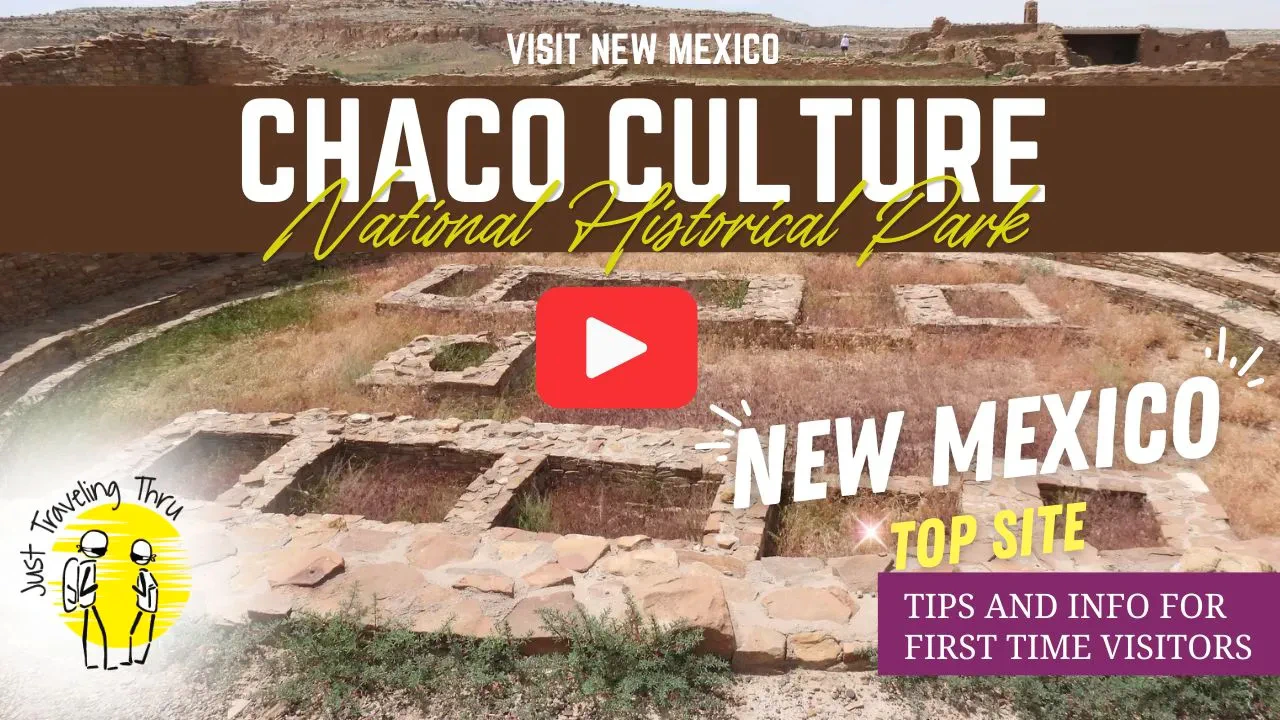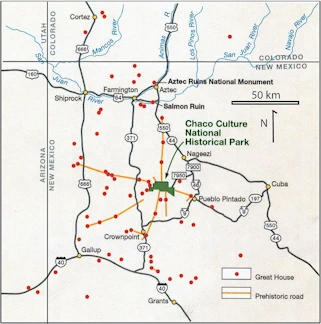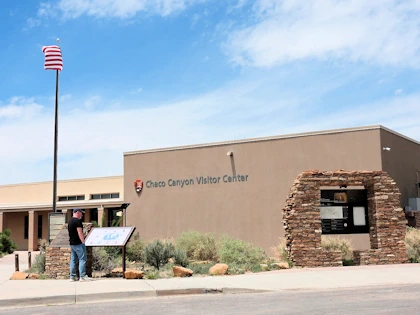by Celeste Lipford and Terry Lipford - last updated on 9/1/2025
Chaco Culture National Historical Park, in New Mexico, is a UNESCO World Heritage Site that offers a profound glimpse into the lives of the Ancestral Puebloans who thrived in the region over a thousand years ago. After visiting Bandelier National Monument, we wondered if Chaco would be 'just another Pueblo ruin,' but it completely exceeded our expectations. Visiting Chaco Culture National Park is like stepping into a real-life history documentary! This extraordinary site is one of the most impressive and awe-inspiring Pueblo ruins we’ve ever seen, allowing you to wander around giant, ancient pueblos that were like ancient apartment buildings.
Chaco Canyon’s significance has evolved over time. Established as a National Monument in 1907, it became a National Historical Park in 1980 and was recognized as a UNESCO World Heritage Site in 1987. What makes Chaco Canyon truly unique is that between 850 and 1250, it emerged as a hub for regional cultures. The Chacoans built massive multi-story stone structures, transforming the area into a ceremonial, administrative, and economic center. Chaco also became a key player in far-reaching trade networks that extended in all directions. Impressively, a system of carefully engineered roads connected the great houses in the canyon to more than 200 sites throughout the region. Although the exact number of inhabitants is uncertain, estimates suggest that thousands of people may have lived in this vast complex.
In the late 12th century the people of Chaco Canyon began to leave and the majority of the population was gone by about 1250 AD.
Chaco Canyon is a UNESCO World Heritage Site
Click here to view that UNESCO Information.
If you enjoy our videos click here to subscribe to our Youtube Channel.
Click the above video poster image to view our exploration of the Chaco Culture National Historical Park, a UNESCO World Heritage Site in New Mexico that was once a thriving hub of Ancestral Puebloan culture. In this video, we’ll show you how to get to the park, highlight key stops along Canyon Loop Drive, like Hungo Pavi and Pueblo Bonito, and give you a sense of how remote and awe-inspiring this destination truly is. This is one of the less visited National Parks in the United States and there is so much to see you won’t be disappointed. Consider replacing Mesa Verde with this park to avoid crowds during your southwest road trip. Inspiring travel and providing information to help you have a great trip
There is no single clear reason for their departure, but there is some conjecture that several factors likely contributed to the abandonment of Chaco Canyon:
In essence, a combination of drought, resource depletion, and shifting social dynamics likely drove the Chacoans to abandon the canyon, but their legacy continued in the region through other settlements and cultures.
Chaco Canyon is located in northwestern New Mexico, and it was the final stop on our journey around the state. Reaching this remote site requires driving at least 16 miles of dirt roads, so it’s not the easiest park to access. We drove from Santa Fe in a small rental car and, while we didn’t encounter any major problems, the roads were far from comfortable. The National Park Service recommends approaching the park via US Highway 550, then following County Roads 7900 and 7950 for the most direct route, which minimizes the distance on dirt roads.
When we left the park to head toward the Bisti Badlands, we consulted the rangers for the best route. We ended up on dirt roads for about an hour and a half before finally reaching Highway 371. There was no cell service or services of any kind on this stretch, making it quite an adventure! If you’re headed north toward Farmington, we recommend leaving the park the way you came, via the northern route.
No matter which direction you’re traveling, be sure to bring plenty of gas, water, food, and snacks, as there are no services within the park — no lodging, gas stations, repair shops, or food options.

The ancient Puebloan road network in and around Chaco Canyon extended over an estimated 400 miles, and is one of the most remarkable aspects of this UNESCO World Heritage site. Developed by the Ancestral Puebloans, the roads connected the canyon to a vast regional system of settlements and outliers, covering large portions of the present-day Four Corners region. Dating back to approximately 900 to 1150 CE, the network featured straight, wide roads that cut through the landscape, sometimes for tens of miles, linking Chaco Canyon's ceremonial center with other significant sites.
The roads were impressively engineered, typically about 30 feet wide, and created using only hand tools, showing the high level of organization and coordination within Puebloan society. Many of the roads radiated outward from Chaco's central complexes, particularly from Great Houses like Pueblo Bonito. Notably, they often led to distant outliers such as Aztec Ruins and Salmon Ruins, emphasizing the Chacoan system’s influence over a large region.
The roads also seem to have had ceremonial or symbolic significance, as they often led to areas without clear economic or settlement purposes. Many archaeologists believe that the road network facilitated not just trade and travel but also spiritual and cultural connections among the dispersed Puebloan communities.
Image Credit: This image is the property of the United States Geological Survey via Wikimedia Commons using the Public Domain License.

The Visitor Center at Chaco Culture National Historical Park is the primary starting point for visitors exploring the ancient ruins and cultural history of the area. Located near the entrance to the park, the center offers an introduction to the unique Ancestral Puebloan civilization that inhabited the region between 900 and 1150 CE. It features a museum with a range of exhibits showcasing artifacts, pottery, tools, and information on the archaeological research conducted at the site.
Visitors can watch a short orientation film that provides an overview of Chaco Canyon’s historical and cultural significance, including its monumental architecture, astronomical alignments, and extensive road network. The center also has a bookstore where visitors can find educational materials about Chaco and other related archaeological sites.
Rangers at the visitor center are available to answer questions, provide maps, and offer advice on exploring the various trails that lead to major ruins like Pueblo Bonito, Chetro Ketl, and Casa Rinconada. There are also guided tours and educational programs available, especially during peak seasons. Additionally, the center offers permits for backcountry hiking and camping within the park, allowing for deeper exploration of this ancient cultural hub
There is a scenic road in Chaco Canyon, known as the Canyon Loop Drive. It is approximately 9 miles long. This road offers access to the park's most important archaeological sites, including Hungo Pavo, Pueblo Bonito, Chetro Ketl, and Casa Rinconada, as well as several other great houses and kivas. Along the loop, there are parking areas and short trails that allow visitors to explore the ruins up close.
Key Sites to Explore
Consists of around 150 rooms, with a single-story design that reached two stories in some parts. The structure also includes a central kiva (a ceremonial room) and a large open plaza. It is believed to have been constructed between 1000 and 1100 AD, making it contemporaneous with other major Chacoan structures. Hungo Pavi is notable for being unfinished. Archaeologists have found evidence that the construction of the great house was never completed, which is somewhat unusual among Chacoan great houses. The reasons for the halt in construction are unknown.
This is one of the largest ancient Great Houses in Chaco Canyon. It covers over 3 acres and contains approximately 500 rooms, including large kivas. The structure was constructed using a mix of sandstone, mud mortar, and wooden beams, reflecting the intricate architectural techniques of the Chacoan people. Chetro Ketl, like other Chacoan Great Houses, likely served as a central hub for social, ceremonial, and possibly administrative functions in the region, indicating the site's importance in the Chacoan culture.
It is the largest and most famous of the "great houses" in Chaco Culture. Constructed by the Chacoans, Pueblo Bonito was built in stages between approximately 828 AD and 1126 AD. This massive D-shaped structure was a central hub for the Chacoan civilization and is considered one of the most impressive archaeological sites in North America.
It covers nearly 3 acres and originally stood up to 4 or 5 stories high in places, with more than 600 rooms and around 40 kivas (circular ceremonial rooms). The building’s D-shape is unique, with its straight back wall aligned against the cliff and a rounded front that opens to a large plaza. At its height, Pueblo Bonito was the largest building in North America until the late 19th century.
Pueblo Bonito was not just a residential area but likely served as a political, ceremonial, and administrative center. It was a hub for trade, religion, and governance. The large number of kivas suggests that religious ceremonies played a central role in the community's life.
Chaco Canyon isn’t just a stop on a Southwest road trip — it’s one of the most significant ancient cultural sites in North America. Between 850 and 1250 AD, this remote desert canyon was the ceremonial and administrative center of the Ancestral Puebloan world. Today, the park preserves massive stone “great houses,” kivas, and intricate road systems that reveal a society far ahead of its time.
For travelers, Chaco is both awe-inspiring and humbling: vast ruins set against open desert skies, with a silence that makes it easy to imagine life here centuries ago. As a UNESCO World Heritage Site, it’s an essential destination for anyone fascinated by archaeology, Indigenous history, or the mysteries of the ancient Southwest.
Interested in the United States UNESCO Sites?
If you are interested in where the United States UNESCO Sites are, take a look at our UNESCO Sites Page.The park is located in northwestern New Mexico, about 150 miles from both Albuquerque and Santa Fe. Access is via long stretches of rural roads — the final 16 miles are unpaved. Click here to view a Google Map.
A lot of websites suggest that a 4WD is required to reach Chaco. In our experience, that wasn’t the case. The dirt road is rough, heavily rutted, and rocky, but with careful driving a standard vehicle can make it without issue. Take it slow, watch for washboard sections, and avoid driving after heavy rains.
Yes. The park has designated parking areas at the visitor center and trailheads for the main ruins.
The visitor center and some major sites have accessible facilities and pathways, though much of the park involves uneven terrain. Some of the walkways through the ruins are uneven, narrow and have steps.
Admission is currently $25 per vehicle (valid for 7 days). America the Beautiful and other NPS annual passes are accepted. Check the NPS website for current information while planning your visit.
The park is open daily, though hours vary by season. The visitor center is typically open from morning to late afternoon. Check the NPS website for current information while planning your visit.
Pueblo Bonito, the largest and most famous great house.
Chetro Ketl and other multi-story stone complexes.
Kivas — ceremonial chambers that still feel sacred today.
Petroglyphs along the canyon walls.
Night skies — Chaco is a certified International Dark Sky Park, making it one of the best stargazing locations in the U.S.
Allow at least an hour to explore.
Families will enjoy the hands-on science stations.
Pair your visit with a stroll through downtown Los Alamos or a stop at nearby Fuller Lodge and Ashley Pond Park.
Hours are 9:00 AM to 5:00 PM Daily.
Spring and Fall are the best time to visit with temperatures ranging from 60 to 80 degrees fahrenheit. Summer can get hot and there is no shade. If you go in the summer, go early in the morning. In the Winter it will be cold at night but could reach the 40s or 50s during peak daylight hours.
The summer months, particularly July and August, can bring monsoons, resulting in sudden thunderstorms. These storms can cause flash flooding, especially in low-lying areas and washes. Check the weather forecast and avoid hiking or driving in the park during severe weather.
The entrance gate to the loop road is closed 30 minutes before the park closing time.
November 1 to February 28 - 7:00 am to 5:00 pm.
March 1 to April 30 - 7:00 am to 7:00 pm.
May 1 to October 31 - 7:00 am to 9:00 pm.
This includes all great houses and parking areas accessed from park roads, back country trails, and outlier sites.
All park facilities are closed on Thanksgiving, Christmas, and New Year's Day. The Gallo campground is closed the day prior to Thanksgiving, Christmas, and New Year's Day.
Yes, the Gallo Campground is located at Chaco Canyon and is surrounded by boulders and cliffs. This is a remote site with no services. Reservations can be made at Recreation.gov. They have tent and RV parking and get 4.5 stars out of 5 on the recreation.gov site.
Private vehicle: $25 for a 7-day pass.
Motorcycle: $20 for a 7-day pass.
Individual: $15 for a 7-day pass.
Commercial vehicle: $40 for a sedan with 1–6 passengers, $40 for a van with 7–15 passengers, $40 for a mini bus with 16–25 passengers, and $100 for a motor coach with 26–46 passengers.
Non-commercial group vehicle: $25 for a vehicle with a seating capacity of 15 or less, and $15 per person age 16 or older for a vehicle with a seating capacity of 16 or more.
Education/academic group: Free.
Cashless Entry Only: Credit and debit cards required to pay entrance fee.
Yes! If you visit National Parks as often as we do, then you should take a look at this pass. The Senior Pass admits the passholder and passengers in a noncommercial vehicle at per-vehicle fee areas and passholder plus three adults, not to exceed four adults, where per-person fees are charged. Children under 16 are always admitted free. The Senior Passes may also provide the passholder (only) a discount on some expanded amenity fees such as camping, swimming, boat launching, and guided tours. View this National Park Page for more information about the pass and how to obtain it.
Covers entrance fees and standard amenity fees (day-use fees) at Federal recreational sites, including national parks. This pass has annual and lifetime purchase options, see this National Park Page for more info.
Chaco Culture National Historical Park is approximately 120 miles (193 kilometers) northwest of Albuquerque, New Mexico. The drive typically takes about 2 to 2.5 hours.
Chaco Culture National Historical Park is approximately 95 miles (153 kilometers) northwest of Santa Fe, New Mexico. The drive typically takes about 2 to 2.5 hours.
In the trip menu list below, a "dark filled circle" represents a destination where we stayed, and the "dark filled arrow" items below that circle location, represent the destinations we visited while in that city or location. A circle icon that is not filled represents a city that we visited or stayed in, but did not necessarily explore.
Click any link below to go directly to that page;
Chaco Culture National Historical Park, NM
Grand Canyon, AZ
Note: All images featured on this page are the exclusive property of Just Traveling Thru, LLC, unless otherwise stated. When images from external sources are used, full credit is given to the original creator, along with a link to the specified license or usage terms. We are committed to respecting copyright and intellectual property rights, ensuring that all third-party images are properly attributed. If you have any questions regarding image ownership or usage rights, please feel free to contact us.
Affiliate Links: We may earn a commission if you make a purchase through one of our affiliate links. This helps support our travel content — thank you!
Content: To review any of our content, make suggestions and/or comments, please click the "About" menu link at the top of this page. You will find our "Contact Us" link on that drop-down menu.